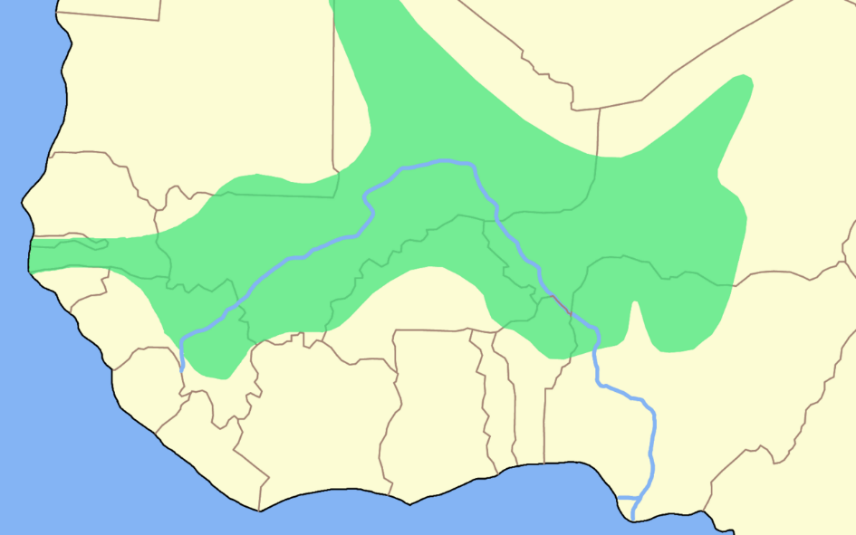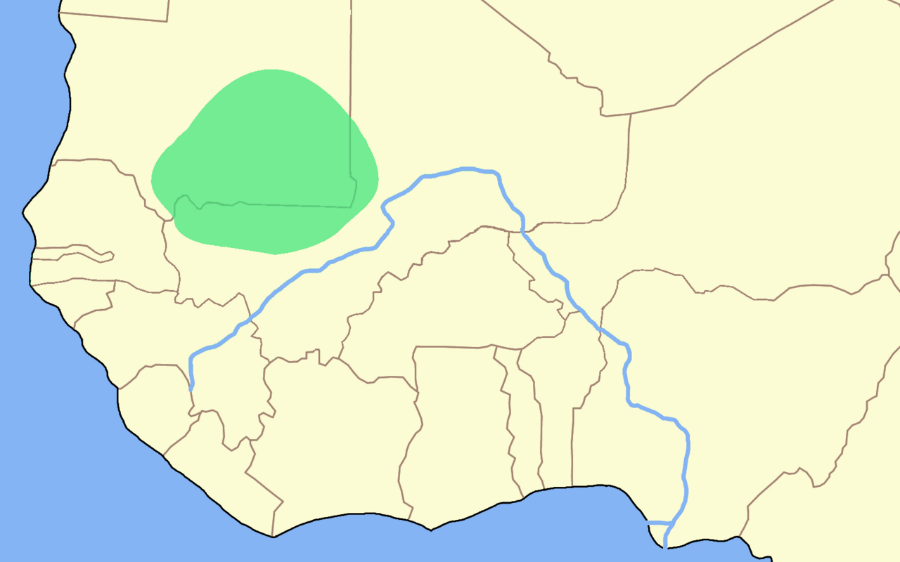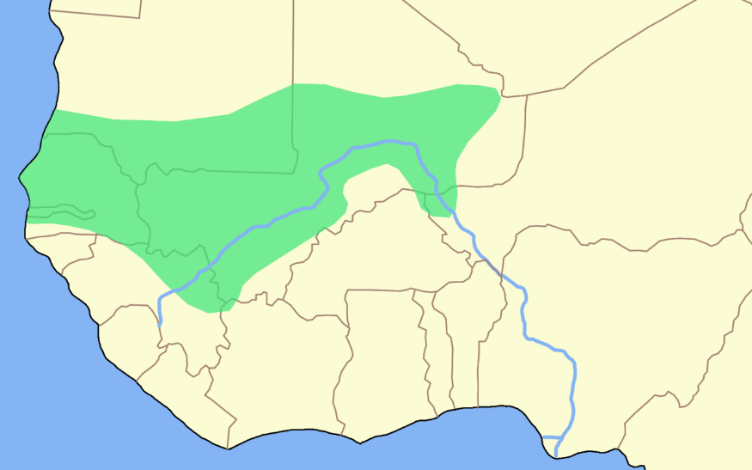The first of the three great sub-Saharan empires, the Ghana Empire, which was powerful at the time of the Islamization of Africa, was weakened by attacks from the Almoravids in the 11th century and began to decline. It was gradually reduced to its original core, corresponding to the kingdom of Ouagadou.
Several other kingdoms (Sosso kingdom, Diarra kingdom, etc.) shared domination of the region controlled by Ghana at its peak.
Map of the Ghana Empire at its height in the 10th century.
Around 1230, Soundiata Keïta, king of Mandé, a region roughly corresponding to present-day Mali, united the Malinké to counter the attacks of the king of Sosso, Soumaoro Kanté. In 1235, at the Battle of Kirina, he defeated his adversary. He then continued his conquests, retaking Koumbi Saleh, the former capital of the Empire of Ghana, from the hands of the king of Sosso. He created the second of the three great empires, the very rich and powerful Empire of Mali, which was expanded, organized, and managed by his successors.
The Mali Empire is also known for the “Manden Charter,” dating from 1222 or 1236, which corresponds to the oath taken by Soundiata Keïta at his enthronement. Considered one of the oldest texts relating to human rights, it is an oral, “constitutional” document relating to human rights and the formal and legal organization governing relations between people. It was not transcribed into writing until the 20th century.
After the reign of Mansa Musa II (around 1387), the empire experienced a period of succession troubles that weakened it. At the same time, the Tuareg Berbers, who had remained permanently rebellious, launched attacks against the cities of the Sahel region, notably Timbuktu, which they seized in 1433. The Portuguese, meanwhile, arrived on the continent at the beginning of the 15th century and traded with the empire while also participating in its weakening by promoting their trade, notably in slaves. They supported the small coastal communities and encouraged them to emancipate themselves.
Map of the Songhai Empire in the 16th century.
Tuareg domination in the northern region was short-lived. Under the leadership of Sonni Ali Ber (“Sonni Ali the Great”), considered a great strategist, the Kingdom of Songhai, which had been tributary to the Mali Empire since 1300, implemented a policy of territorial conquest, breaking with the raiding-based economy that had prevailed until then. He fought and defeated the Fulani and the Tuareg, and he reclaimed Timbuktu in 1468. This was the advent of the third empire, the Songhai Empire, which developed during the 15th and 16th centuries, building on territorial conquest and a political organization largely inspired by that of the Mali Empire.
Sonni Ali, a “facade” Muslim, remained faithful to Songhai traditions. Upon his death, the Muslim party prevailed, and the Songhai Empire was ruled by a Muslim dynasty, the Askia dynasty, which brought the empire to its peak in the 16th century. At the end of the 16th century, civil wars, combined with assaults by the Saadians—who contested Songhai’s possession of the salt mines of Teghazza in the Sahara—further weakened the empire. The Battle of Tondibi, lost against the Saadians on April 12, 1591, marked the end of the empire and its allegiance to the Sultan of Morocco.
Map of the Songhai Empire in the 16th century.
For more information :
- https://fr.wikipedia.org/wiki/Portail:Afrique
- https://en.wikipedia.org/wiki/Africa
- https://africacenter.org/
- https://journals.openedition.org/etudesafricaines/
- https://etudes-africaines.cnrs.fr/
- https://journals.openedition.org/etudesafricaines/
- https://www.afdb.org/fr/documents-publications/economic-perspectives-en-afrique-2024



